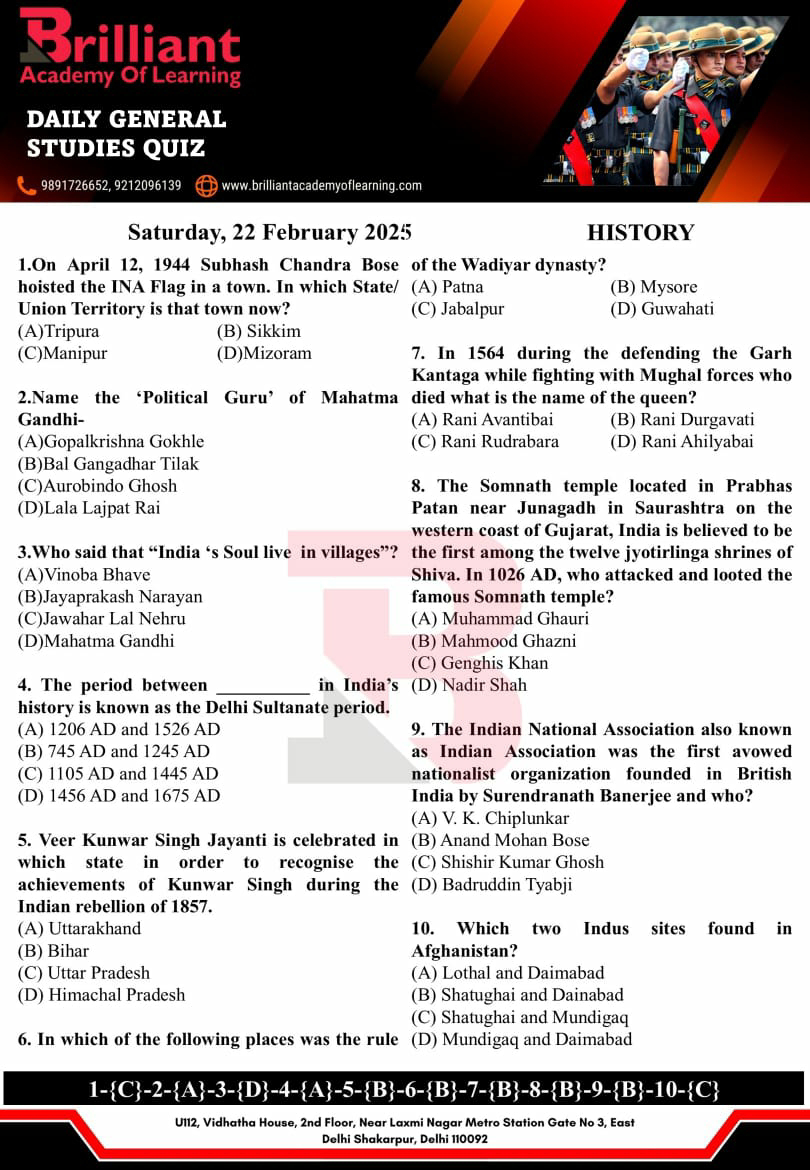भारतीय संविधान (Indian Constitution) Important Facts (महत्वपूर्ण तथ्य) By NM Mishra @Brilliant Academy of Learning, Laxmi Nagar, Delhi
https://www.brilliantacademyoflearning.com/courses.html
1. Maximum Strength of Legislative Council (विधान परिषद की अधिकतम सदस्य संख्या) ~~ उस राज्य के विधान सभा का एक तिहाई (one third of the strength of Legislative Assembly of that State)
2. Minimum Strength of Legislative Council (विधान परिषद की न्युनतम संख्या) ~~ 40
3. Maximum Strength of Legislative Assembly (विधान सभा की अधिकतम सदस्य संख्या) ~~ 500
4.Minimum Strength of Legislative Assembly (विधान सभा की न्युनतम संख्या) ~~ 60
Exceptions (अपवाद) ~~ सिक्किम और गोवा के विधान सभा में क्रमशः 32और 40 सदस्य हैं। Sikkim and Goa legislative Assemblies have respective 32 and 40 members.
5. Present Strength of Lower House (लोक सभा की वर्तमान सदस्य संख्या) ~~ 543
6.Maximum Strength of Lower House (लोक सभा की अधिकतम सदस्य संख्या) ~~ 550
7. Present strength of Council of States/Upper House (राज्य सभा की वर्तमान सदस्य संख्या) ~~ 245
8. Maximum Strength of Council of States/Upper House (राज्य सभा की अधिकतम सदस्य संख्या) ~~ 250
9. Who provides oath to President of India? राष्ट्रपति को शपथ कौन दिलवाता है? ~~ Chief Justice of India (भारत के मुख्य न्यायाधीश)
10. To whom president gives his resignation? राष्ट्रपति किसको अपना त्यागपत्र देता है? ~~ Vice president of India (भारत के उपराष्ट्रपति को)
11. Who provides oath to Vice President of India ? (उपराष्ट्रपति को शपथ कौन दिलवाता है?) ~~ President of India (भारत के राष्ट्रपति)
12. उपराष्ट्रपति अपना त्यागपत्र किसे देता है? ( To whom Vice-president provides his resignation?) ~~ To President of India (भारत के राष्ट्रपति को)
13. Who is the ex-officio Chairman of Council of States? राज्य सभा के पदेन अध्यक्ष कौन होते हैं ? ~~ Vice President of India (भारत के उपराष्ट्रपति)
14. Who and how Chief Minister is appointed ? मुख्यमंत्री की नियुक्ति कौन करता है और कैसे ? ~~ The Governor appoints Chief Minister under Article 164 . The Governor appoints that person as Chief Minister whom he believes,enjoys confidence of Legislative Assembly . (राज्यपाल अनुच्छेद 164 के तहत मुख्यमंत्री को नियुक्त करता है। वह उस व्यक्ति को मुख्यमंत्री नियुक्त करता है जिसमें उन्हें विश्वास होता है की विधान सभा का बहुमत उसके साथ है।)
15. How is Governor appointed? राज्यपाल की नियुक्ति कैसे होती है ? ~~ Governor is appointed by the President under Art 155 . राज्यपाल की नियुक्ति राष्ट्रपति द्वारा अनुच्छेद 155 के तहत होती है।
16. How are members of Upper House/Council of States elected ? राज्य सभा के सदस्यों का निर्वाचन कैसे होता है ? ~~~ The members of Council of States/Upper House are elected by members of Legislative Assemblies and 12 eminent members are nominated by the President.
राज्य सभा के सदस्यों का निर्वाचन विधान सभा के सदस्यों द्वारा की जाती है और 12 प्रसिद्ध व्यक्तियों का नामांकन राष्ट्रपति द्वारा किया जाता है।
17. How is Vice-president elected? उपराष्ट्रपति का निर्वाचन कैसे होता है ? ~~~ The vice-president is elected by members of Lower House and Upper House. उपराष्ट्रपति का निर्वाचन लोकसभा और राज्यसभा के सदस्यों के द्वारा होता है।
18. How is president of India elected? राष्ट्रपति का निर्वाचन कैसे होता है? ~~~ The president is elected by an electoral college consisting of elected members of Lower House, Upper House and Legislative Assemblies through Proportional representation by Single transferable secret ballot. राष्ट्रपति का निर्वाचन एक निर्वाचक मंडल द्वारा होता है जिसमें लोक सभा, राज्य सभा और विधान सभा के निर्वाचित प्रतिनिधि होते हैं और समानुपातिक प्रतिधिनित्व द्वारा एकल संक्रमणीय पद्धति तथा गुप्त मतदान द्वारा होता है।
19. How and who appoints the Prime Minister? प्रधान मंत्री की नियुक्ति कौन और कैसे करता है ? ~~~ Prime Minister is appointed by the President under Art 75 by the President and he appoints that person as Prime Minister whom he thinks enjoys the confidence of Lower House. प्रधानमंत्री की नियुक्ति राष्ट्रपति द्वारा अनुच्छेद 75 के तहत की जाती है और उस व्यक्ति को वह प्रधानमंत्री नियुक्त करता है जिसमें उसे विश्वास हो की लोकसभा का बहुमत उसके साथ है।
20. What can be maximum gap between two sessions of Loksabha and Vidhan Sabha? लोक सभा और विधान सभा के दो सत्रों के बीच अधिकतम कितना अंतराल हो सकता है ? ~~ 6 months (6महीने का)
21. Who summons joint sessions of Parliament and who presides it ? संसद का संयुक्त अधिवेशन कौन बुलाता है और उसकी अध्यक्षता कौन करता है ? ~~ The president summons joint session of parliament and it is presided by Speaker of Loksabha . संसद का संयुक्त अधिवेशन राष्ट्रपति बुलाता है और लोक सभा के अध्यक्ष इसकी अध्यक्षता करता है।
22. Tell few points about Money Bill . धन विधेयक के बारे में कुछ बिंदु बताएं। ~~ Bill related to expenditure of the Government is called Money Bill. Money Bill has been described under Art 110. Money Bill is introduced after recommendation of the president. Money Bill is always introduced in Loksabha. Rajya sabha can keep Money Bill for maximum 14 days . If there is any dispute in the parliament whether particular bill is Money Bill or not decision of Speaker of Loksabha will be final . If money Bill is passed by Loksabha and rejected by Rajyasabha , then also it is considered pass . Rajya sabha can keep Money Bill maximum for 14days.
23. How Legislative Council of States (Vidhan Parishad) is composed? विधान परिषद का गठन कैसे होता है ? What can be maximum and minimum strength of Vidhan Parishad? How many states have Vidhan Parishad?
According to Art 169 of Indian Constitution Union Parliament can create or abolish Vidhan Parishad (State Legislative Council) if State Legislative Assembly (Vidhan Sabha) passes a resolution for that with Special Majority (Majority of Strength of Vidhan Sabha and two third members present and voting ). As of now there are 6 out of 28 states having Legislative Council (Vidhan Parishad) namely Andhra Pradesh,Telengana,Uttarpradesh,Bihar, Maharashtra and Karnataka. Now Jammu and Kashmir has no Legislative Council because it was made Union Territory in 2019. As per art 171 maximum strength of Legislative Council can be one third of strength of Legislative Assembly of that state and minimum strength of Legislative Council can be 40.
Composition of Legislative Council: One third of members(MLC) are elected by MLA (members of Legislative Assembly) of that State; one third by Special electorate comprising sitting members of local government such as municipalities and district boards; one twelveth by an electorate of teachers; one twelveth by registered graduates; one sixth are nominated by Governor for distinguished services in various fields like literature,Art, Social service , Science and Co-operative Movement.
24. How is speaker of Lok Sabha (Lower House) and Deputy Speaker of Lok Sabha elected?
The speaker of Lok Sabha and Deputy Speaker of Lok Sabha is elected by members of Lok Sabha as per Art 93 on the date fixed by the President of India.
25. How is speaker of Legislative Assembly elected?
The Speaker of Legislative Assembly(Vidhan sabha) is elected by members of Vidhan sabha.
26. How is chairman of Legislative Council (Vidhan Parishad) elected?
The chairman of Vidhan Parishad is elected by the members of Vidhan Parishad.
27. By which Constitutional Amendments Panchayati Raj and Urban Local Government were given Constitutional Status?
By 73rd Constitutional Amendments 1992 , Panchayati Raj was given Constitutional Status. Three tier Structure of Panchayati Raj is Gram panchayat, Panchayat Samiti and Zilla Parishad. Provisions related to Panchayati Raj was put in eleventh Schedule.
By 74th Constitutional Amendment Act 1992 urban local government was given Constitutional Status. Three tier Structure is Nagar panchayat,Municipality and Municipal corporation. Provisions related to Urban Local Government were put in 12th Schedule.
28. When was Panchayati Raj established?
Panchayati Raj was established on 2nd October 1959. The first place where Panchayati Raj was established was Nagore,Rajasthan on 2nd October 1959. The second state to implement Panchayati Raj was Andhra Pradesh.
29. How many constitutional Amendments have been in India till 13 April 2025 ?
There have been 106 constitutional Amendments till 13 April 2025 in India.
106 th Constitutional Amendment provides one third reservation in Seats in Lok Sabha and Vidhan Sabhas to women.
30. How many High Courts and Supreme Court is in India till January 2024?
There is one Supreme Court in India situated in Delhi which is highest court of Appeal and at the apex of Justice in India. There are 25 High Courts presently in India.
31. Who provides oath to MPs in Lok Sabha?
The Protem Speaker provides oath to MPs in Lok Sabha.
32. Who appoints Protem Speaker of Lok Sabha?
The President appoints Protem Speaker under Art 95(1).
33. Who provides oath to Protem Speaker?
The President of India provides oath to Protem Speaker.
34. Who provides oath to Speaker and Deputy Speaker of Lok Sabha?
No one provides oath to Speaker and Deputy Speaker of Lok Sabha.
35. To whom Speaker of Lok Sabha gives his resignation?
The Speaker of Lok Sabha provides his resignation to Deputy Speaker of Lok Sabha.
36. To whom Deputy Speaker of Lok Sabha provides his resignation?
The Deputy Speaker provides his resignation to Speaker of Lok Sabha.
37. What are the constitutional amendments made since BJP Government under Narendra Modi came in power in 2014 ?
1. 99th Constitutional Amendment 2014 was related to appointment of Judges of High court and Supreme court by National Judicial Appointment Commission (NJAC) instead of existing collegium system . But in 2015 Supreme court declared it unconstitutional on the ground that it violated Basic Structure of the Constitution.
2. 100 th Constitutional Amendment 2015 is related to exchange of territories with Bangladesh.
3.101st constitutional amendment 2016 is related to introduction of GST(Goods and Services Act)
4.102nd Constitutional Amendment Act 2018 is related to establishment of National Commission for Backward classes (NCBC ).
5.103rd Constitutional Amendment Act 2019 is related to introduction of 10% reservation for Economically Weaker Sections (EWS) in Education and Employment.
6. 104th Constitutional Amendment Act 2020 has removed the reservation of Seats of Anglo Indian community in Loksabha and Vidhan Sabhas . It has also extended the reservations for Scheduled Castes and Scheduled Tribes in Loksabha and Vidhan Sabhas till 2030.
7. 105th Constitutional Amendment Act 2021 has provided the power to State Governments to identify Socially and Educationally Backward Classes (SEBC). Now List of States for SEBC may differ from Central Government's list.
8. 106th Constitutional Amendment Act 2023(Nari Shakti Vandan Adhiniyam) has provided reservations of one third of Seats in the Loksabha and State Legislative Assemblies (Vidhan Sabhas) for Women. This also has a provision of Quota within a quota for SC and ST communities.
9. Waqf Amendment Act 2025 will regulate Waqf properties in India and repeal Mussalman Waqf Act , 1923 and amend Waqf Act ,1995 . The Act has been renamed as UWMEED Act ,1995(United Waqf Management, Empowerment, Efficiency and Development Act, 1995).
38. How was special status for Jammu and Kashmir under Art 370 removed?
The Union Government (Central Government) by a Presidential order abrogated Art 370 on 5th August 2019 . Later on Jammu and Kashmir State was reorganized into two separate union territories of Jammu and Kashmir; and Ladakh.
On 11 December 2023 , a 5 Judge Constitution Bench formed by Supreme Court unanimously upheld the constitutionality of abrogation of Art 370 of the constitution.





Your blog is a breath of fresh air in a crowded online space.
ReplyDeleteAslo read this post SSB Coaching in Dwarka